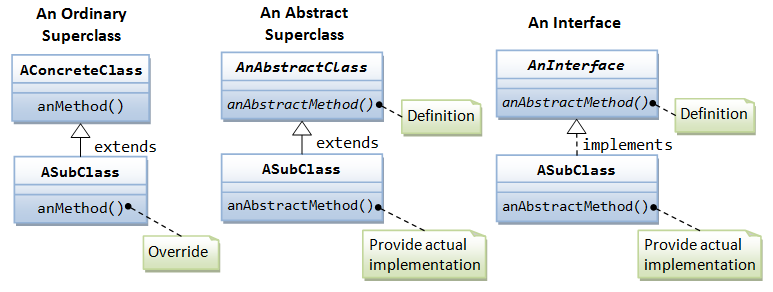Java SE: Abstract/Interface
Java Fundamentals
📘 Abstract/Interface
Abstraction and particulary Interfaces provide a way for multiple classes to share a common set of methods or properties, without inheriting from a common base class.
Interfaces are the tool when the code needs order, be clear and be easly readable.
This allows for greater flexibility in designing and implementing classes, as well as allowing for multiple inheritance.
Interfacesalso promote code reuse and can be used to define contracts for classes to implement, which can help ensure that certain methods or properties are present in a class.
Additionally, Java’s support for
defaultmethods in interfaces allows for the addition of new methods to an interface without breaking existing code that implements the interface.
1 Abstract/Interface
Data abstraction is the process of hiding certain details and showing only essential information to the user.
Abstraction can be achieved with either:
- abstract classes or
- interfaces
An interface is a completely “abstract class” that is used to group related methods with empty bodies
1.1 Abstract class
The abstract keyword is a non-access modifier, used for classes and methods:
Abstract class: is a restricted class that cannot be used to create objects (to access it, it must be inherited from another class).
Abstract method: can only be used in an abstract class, and it does not have a body. The body is provided by the subclass (inherited from).
moviemodel.java
// Abstract class
abstract class Animal {
// Abstract method (does not have a body)
public abstract void animalSound();
// Regular method
public void sleep() {
System.out.println("Zzz");
}
}
// Subclass (inherit from Animal)
class Pig extends Animal {
public void animalSound() {
// The body of animalSound() is provided here
System.out.println("The pig says: wee wee");
}
}1.2 Interface
To access the interface methods, the interface must be “implemented” (kinda like inherited) by another class with the implements keyword (instead of extends). The body of the interface method is provided by the “implement” class:
moviemodel.java
// Interface
interface Animal {
public void animalSound(); // interface method (does not have a body)
public void sleep(); // interface method (does not have a body)
}
// Pig "implements" the Animal interface
class Pig implements Animal {
public void animalSound() {
// The body of animalSound() is provided here
System.out.println("The pig says: wee wee");
}
public void sleep() {
// The body of sleep() is provided here
System.out.println("Zzz");
}
}- Like abstract classes, interfaces cannot be used to create objects
- Interface methods do not have a body - the body is provided by the “implement” class
- On implementation of an interface, you** must override all of its methods**
- Interface methods are by default abstract and public
- Interface attributes are by default public, static and final
- An interface cannot contain a constructor (as it cannot be used to create objects)
2 Pros & cons of interfaces
2.1 Pros of using interfaces:
- Interfaces provide a way to define a contract that classes must implement, ensuring that certain methods or properties are present. Interfaces allow for multiple inheritance, allowing a class to implement multiple interfaces.
- Interfaces promote code reuse by allowing multiple classes to share a common set of methods or properties.
- Java’s support for default methods in interfaces allows for the addition of new methods to an interface without breaking existing code that implements the interface.
- Interfaces can be used to define a common API for different implementations of a specific functionality.
2.2 Cons of using interfaces:
- An interface does not provide any implementation for its methods or properties, so classes that implement an interface must provide their own implementation.
- Interfaces can lead to more complex code, as it may require more effort to understand how the different classes and interfaces relate to each other.
- Interfaces can make it more difficult to understand the relationships between classes, as it may not be immediately clear which classes implement a specific interface.
- Interfaces can lead to a proliferation of small, highly-specialized interfaces, which may make the codebase harder to understand and maintain.
Java does not support “multiple inheritance” (a class can only inherit from one superclass). However, it can be achieved with interfaces, because the class can implement multiple interfaces.
